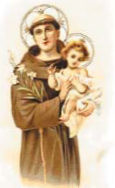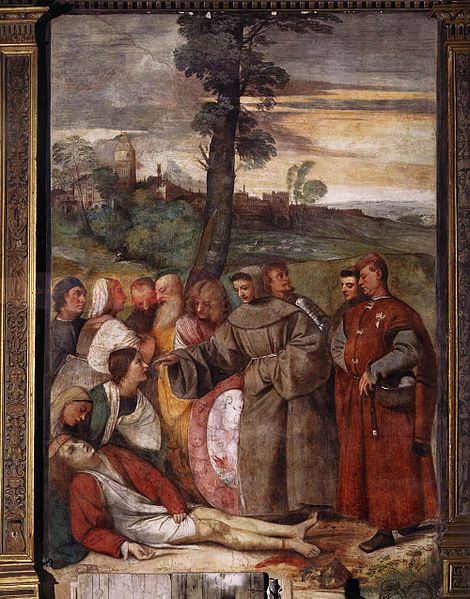There is a tendency nowadays to depict saints as people who bypass the realities of life and somehow attain sanctity with little effort.
Here we have two pictures of Saint Anthony of Padua. The first is a fresco in the basilica dedicated to the saint in Padua, Italy, and it is the oldest known depiction of the great thirteenth century apostle and miracle worker. In this picture, we see a powerfully built Franciscan, his expression young though mature, serious and determined.
 The second is a holy card bought in the souvenir shop of the same basilica. This depiction is obviously not inspired by the fresco. Here we see a delicate, rosy cheeked young man, his face devoid of the natural masculinity necessarily brought on by the preacher’s arduous life. His is sentimental, of soft countenance, devoid of the personality and strength of character necessary for climbing the mountain of perfection.
The second is a holy card bought in the souvenir shop of the same basilica. This depiction is obviously not inspired by the fresco. Here we see a delicate, rosy cheeked young man, his face devoid of the natural masculinity necessarily brought on by the preacher’s arduous life. His is sentimental, of soft countenance, devoid of the personality and strength of character necessary for climbing the mountain of perfection.
Anthony was born Ferdinand of Bouillon of a Portuguese noble family. Early in life he engaged in the pursuit of virtue and suffered vicious attacks from the devil in an attempt to break his resolve. At fifteen he joined the Augustinians, and applied himself to prayer and intense study.
Since childhood, Ferdinand harbored the ardent desire to lay down his life for his Lord and his Faith. Hearing of the martyrdom in Africa of five Franciscan missionaries he knew, he joined the Franciscans hoping for the same fate, and took the name Anthony. Soon after, he was sent with a companion to Africa but Providence had other designs. On landing, Anthony fell ill and returned to Portugal. A violent storm re-routed his ship to Italy where, making use of his brilliant eloquence, he defended his order against evil machinations.
After a life of intense apostolate, astounding miracles and constant preaching against the enemies of the Church, for which he was named “Hammer of Heretics,” the saint died exhausted by his labors at only 36. He was canonized shortly after his death in view of the irrefutable miracles he performed in life and in death.
Although meant to be pious, the second holy card pictured here fails to give us a realistic idea of holiness. Saints Paul and John of the Cross speak of the journey of salvation as a “race” and an “ascent,” respectively, which require commitment, determination and fortitude.
According to Professor Plinio Corrêa de Oliveira, “The honors of the altar are not granted to hypersensitive and weak souls that flee from profound thought, bitter suffering and the battle ground—that is, the cross of Our Lord Jesus Christ.”
Although God’s constant grace accompanies the willing on the road to sanctity, it does not cancel the human struggle against the pull of our fallen natures. The marks of the effort are to the saint what the scars are to the soldier – their true glory.
Hence, far from glossing over these realities, we should seek to depict them realistically as the earned halo and medal.
(Crusade Magazine, Jan-Feb 2007, pg. 24)
—————–
Life of St. Anthony of Padua
Doctor of the Church and Miracle-Worker
(1195-1231)
Born in Lisbon, Portugal, in 1195, Fernando de Bouillon was of a noble family related to the famous Godefroy de Bouillon, founder and first sovereign of the Latin Kingdom of Jerusalem, who at the close of the Crusade of 1099 had refused to wear a crown, there where Christ had worn one of thorns.
Favored by nature and grace, Fernand resolved at the age of fifteen to leave the world and consecrate himself to God in the Order of Canons Regular of Saint Augustine. No flattery, threat or caress of his relatives could persuade him to leave that holy refuge. He asked to be transferred to another convent to avoid the family’s solicitations, and was sent to Coimbra. Still young, his sanctity became evident through miracles; he cured a poor religious whom the devil was obsessing, by covering him with his cloak.
When this young monk decided, after witnessing the return of the martyred remains of five Franciscans who had gone to Africa, to join that Order so favored with the graces of martyrdom, the Augustinians were desolate but could not prevent his departure, for Saint Francis himself appeared to him in a vision in July 1220, and commanded him to leave. He was then sent by the Franciscans to Africa, but two years later was obliged to return to Italy because of sickness; thus he was deprived of the martyr’s crown he would have been happy to receive.
In 1222 Anthony, as he was now called, went with other Brothers and some Dominican friars to be ordained at Forli. There Fra Antonio rose under obedience to preach for the first time to the religious, and took for his theme the text of Saint Paul: Christ chose for our sake to become obedient unto death. As the discourse proceeded, “the Hammer of Heretics,” “the Ark of the Testament,” “the eldest son of Saint Francis,” stood revealed in all his sanctity, learning, and eloquence before his rapt and astonished brethren. He had been serving in the humblest offices of his community; now he was summoned to emerge from this obscurity. And then for nine years France, Italy, and Sicily heard his voice and saw his miracles, whose numbers can scarcely be counted. A crowd to which he was preaching outdoors one day, when the church was too small to hold all who came to hear him, amidst thunder and lightning felt not one drop of water fall upon them, while all around them the rain poured down. And men’s hearts turned to God.

At Padua also took place the famous miracle of the amputated foot. A young man, Leonardo by name, in a fit of anger kicked his own mother. Repentant, he confessed his fault to St. Anthony who said to him: “The foot of him who kicks his mother deserves to be cut off.” Leonardo ran home and cut off his foot. Learning of this, St. Anthony took the amputated member of the unfortunate youth and miraculously rejoined it.
After a number of years of teaching of theology, unceasing preaching and writing, Saint Anthony, whose health was never strong, was spending a short time of retreat in a hermitage near Padua. He was overcome one day with a sudden weakness, which prevented him from walking. It progressed so rapidly that it was evident his last days had arrived. He died at the age of thirty-six, after ten years with the Canons Regular and eleven with the Friars Minor, on June 13, 1231. The voices of children were heard crying in the streets of Padua, “Our father, Saint Anthony, is dead.” The following year, the church bells of Lisbon rang without ringers, while in Rome one of its sons was inscribed among the Saints of God.
Sources: Les Petits Bollandistes: Vies des Saints, by Msgr. Paul Guérin (Bloud et Barral: Paris, 1882), Vol. 6; Little Pictorial Lives of the Saints, a compilation based on Butler’s Lives of the Saints, and other sources by John Gilmary Shea (Benziger Brothers: New York, 1894).









